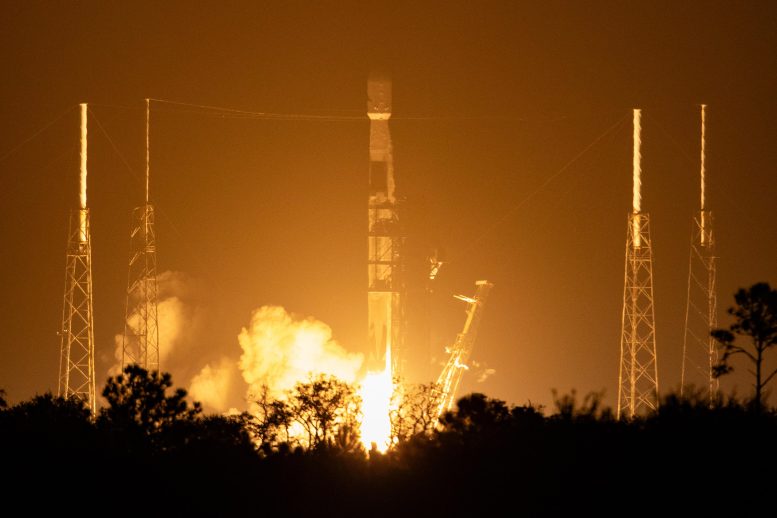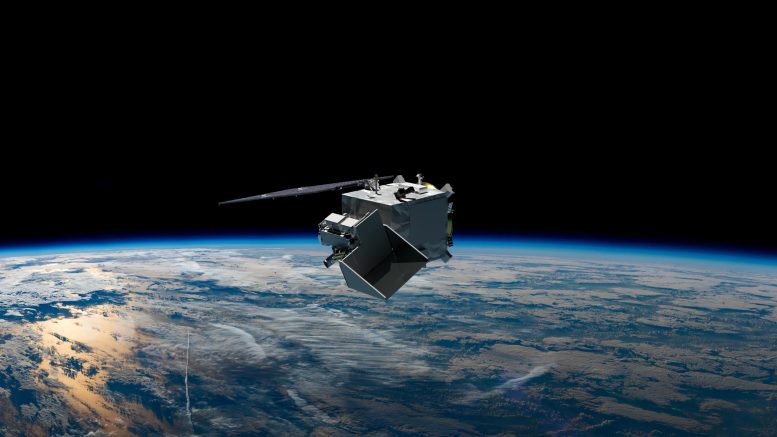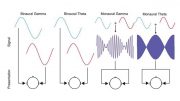
NASA’s PACE (Plankton, Aerosol, Cloud, ocean Ecosystem) spacecraft, atop a SpaceX Falcon 9 rocket, successfully lifts off from Space Launch Complex 40 at Cape Canaveral Space Force Station in Florida at 1:33 a.m. EST Thursday, Feb. 8. PACE is NASA’s newest earth-observing satellite that will help increase our understanding of Earth’s oceans, atmosphere, and climate by delivering hyperspectral observations of microscopic marine organisms called phytoplankton, as well new data on clouds and aerosols. Credit: NASA/Kim Shiflett
NASA’s PACE satellite lifted off from Florida and headed for orbit, from where it will observe microscopic organisms in Earth’s oceans and particles in the air.
The newest NASA Earth science satellite successfully launched from Cape Canaveral Space Force Station in Florida on February 8, 2024. This photo was taken during launch, just after 1:33 a.m. Eastern Time, as the SpaceX Falcon 9 rocket lifted off carrying NASA’s PACE (Plankton, Aerosol, Cloud, ocean Ecosystem) spacecraft.
From hundreds of miles above Earth, PACE will study the impact of tiny, often invisible things: microscopic life in water and microscopic particles in the air. “PACE is a mission that will use the unique vantage point of space to study some of the smallest things that can have the biggest impact,” said Karen St. Germain, director of NASA’s Earth Science Division.
With the combination of a hyperspectral instrument and polarimeters, PACE will provide insights into the interactions between the ocean and atmosphere, and how a changing climate affects these interactions.

Satellite image of a phytoplankton bloom off the coast of South Australia captured on January 21, 2024, by the Operational Land Imager-2 on Landsat 9.
Microscopic phytoplankton in the ocean can develop into blooms vast enough to be visible from orbit. For example, this natural-color image (above), acquired by the OLI-2 (Operational Land Imager-2) on Landsat 9, shows a bloom off the coast of South Australia. But scientists have not been able to say with certainty, based on satellite images alone, which types of phytoplankton composed blooms like this one.
PACE’s hyperspectral OCI (Ocean Color Instrument) will measure oceans and other waterbodies across a spectrum of ultraviolet, visible, and near-infrared light. This will enable scientists to track the distribution of phytoplankton and—for the first time from space—identify which communities of these organisms are present on daily, global scales. Scientists and coastal resource managers can use the data to help forecast the health of fisheries, track harmful algal blooms, and identify changes in the marine environment.
The spacecraft also carries two polarimeter instruments that will detect how sunlight interacts with particles in the atmosphere. These data can provide researchers with new information on atmospheric aerosols and cloud properties, as well as air quality at local, regional, and global scales.
Though NASA has been studying aerosols from space for decades—observing their location and abundance—PACE and its SPEXone and HARP2 polarimeters will change the game. The instruments will reveal the shape and size of aerosols, helping scientists answer questions about where they come from and how they might influence other parts of the Earth system.

NASA’s PACE (Plankton, Aerosol, Cloud, ocean Ecosystem) spacecraft in orbit over Earth. Credit: NASA GSFC
After launch on February 8, the spacecraft successfully contacted ground stations on Earth, providing teams with early readings of its postlaunch status, health, operation, and capabilities. A full postlaunch assessment review of PACE’s readiness to move into the operational phase of its mission will be conducted in the coming weeks.
Photograph by NASA. NASA Earth Observatory image by Lauren Dauphin, using Landsat data from the U.S. Geological Survey. Video by Ryan Fitzgibbons (KBRWyle)/NASA’s Goddard Space Flight Center/Scientific Visualization Studio.









Be the first to comment on "Unlocking Earth’s Microscopic Mysteries With NASA’s PACE"